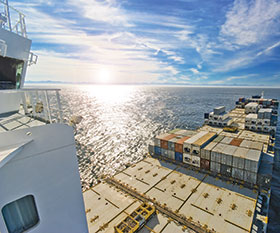

Environmental regulations for ships are getting more stringent, but automated sensor technology could help ship operators remain in compliance, says Claus Beiersdorfer, SKF sales director.
The recent agreement signed in Paris, at the UN Climate Change Conference, will require all industries to keep reducing their greenhouse gas (GHG) emissions. Although there was no specific mention of shipping, the aim of keeping global temperature rises below 2ºC this century will require the industry to play its part – as it is responsible for about 2% of global CO2 emissions.
Environmental rules get tougher
Environmental rules for the industry are enshrined in the MARPOL (marine pollution) regulations as well as several local regulations, such as VGP (vessel general permit) 2013, which set strict emission limits. Emission targets in open water are less stringent, allowing high-sulphur fuel to be used there, for example. However, closer to shore – or in special areas such as the Baltic Sea – these targets are far stricter, so ships must switch over to a ‘cleaner’ fuel.
These rules are only going to get tougher: as a special area under Annexe IV of MARPOL, the Baltic Sea will fall under tough new regulations for wastewater discharge, for example. The rules were introduced in 2016 for new passenger vessels, and by 2018 for existing vessels.
The punishment for breaking MARPOL rules can be severe, particularly in the US. For example, recent cases include a German management company fined $800 000 for breaking the Clean Water Act, and an Italian ship owner fined $2,75 million for infringing the Act to Prevent Pollution from Ships. In each case, both the operating company and individual members of the crew were held to be at fault and received fines or community service orders.
At the same time, the US Coast Guard recently issued a Safety Alert, regarding the use of ultra-low sulphur (ULS) fuel. It recommends that switching to ULS fuel – which can result in loss of propulsion – is accomplished outside of busy traffic lanes. As part of the guidance, it says: “Ensure all sensors, controls and alarms are operational and function as designed.”
Automated condition monitoring with SKF’s BlueMon
Condition Monitoring (CM) uses sensors to assess the health of components such as bearings and is commonplace in the manufacturing industry. CM has taken a few tentative steps into shipping, but it is early days: many ship owners, while recognising the benefits, are reticent to invest in such systems.
This type of automated, sensor-based system can also be used for functional monitoring: instead of spotting bearing failure, it could automatically monitor critical environmental attributes such as fuel consumption and GHG emissions. This is the basis behind SKF’s BlueMon.
Often the necessary sensors are already on board and monitored by the crew. What BlueMon does is automate the whole process and add an extra level of security by helping the crew avoid mistakes: most importantly, it overlays all this information with positional data. Marrying environmental and GPS data is a vital resource that helps ship owners and operators to stay within the MARPOL regulations. For example, BlueMon will sound a warning when the ship is approaching the shore – meaning that it must shift to a cleaner fuel, for example, or must not discharge bilge water overboard.
Bilge water must be fed through a separator until it is clean enough to be discharged. Out at sea, it can contain 15 parts per million of oil and be safely discharged. Closer to shore, the levels can drop to 5ppm – or even to zero bilge water discharge. By knowing the exact position of the ship – and correlating it with sensor readings – the system will take charge, and shut off the bilge water discharge valve if necessary.
With BlueMon, data is logged automatically by the system and kept for 24 months. In the case of a dispute, a log of all activities – from fuel-switching to bilge discharge – is available, with a precise location.
For now, the system is restricted to the ship itself. There is no ship-to-shore transmission of data – although this is likely to be introduced in future. Such an arrangement is already in place for on-board CM: rather than having multiple maintenance experts on every ship, a fleet owner can transmit CM data back to shore, where remote experts can analyse all the data and act accordingly. This type of remote monitoring is already being used for route optimisation. Data is transmitted to onshore experts, who may determine that the most cost-effective route is a longer journey using heavier fuel, for example.
For more information contact Samantha Joubert, SKF South Africa, +27 (0)11 821 3602, [email protected], www.skf.co.za
| Tel: | +27 11 821 3500 |
| Email: | [email protected] |
| www: | www.skf.co.za |
| Articles: | More information and articles about SKF South Africa |

© Technews Publishing (Pty) Ltd | All Rights Reserved